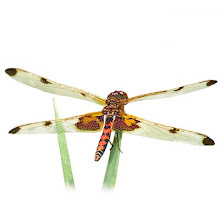Friday, July 13, 2007
July 9, 2007
This was a frustrating day when I seemed completely unable to get close to any insects without spooking them. Fortunately, those days are infrequent.
But a couple of photos made up for the whole irritating experience. I managed to sneak up on this Halloween Pennant; you know it’s hot when the dragonflies start to overheat. Obelisking dragonflies orient their bodies so the abdomen points toward the sun, minimizing absorption of the direct rays of the sun.
These treehoppers (Homoptera Membracidae) were being tended by ants. Treehoppers produce honeydew, which is consumed by ants. In a mutually beneficial relationship, the ants protect the treehoppers from predators in exchange for the food.
July 7, 2007
Is there any better way to spend a summer morning than sitting at the edge of a pond watching dragonflies? I watched a wide variety at a pond created decades ago when the land was strip-mined: Twelve-spotted Skimmer, Eastern Pondhawk, Blue Dasher, Halloween Pennant, Banded Pennant, Red Saddlebags, Slaty Skimmer, Widow Skimmer and Eastern Amberwing.
I noticed this Black and Yellow Mud Dauber (Hymenoptera Sphecidae Sceliphron sp.) gathering mud at the edge of the pond.
Juniper Hairstreak (Callophrys gryneus)
July 6, 2007
A Juniper Hairstreak was nectaring at milkweed this afternoon. Juniper Hairstreaks, the only green butterfly in Missouri, overwinter as a chrysalis. The caterpillars eat leaves of eastern red cedar.
July 3, 2007
A pair of dung beetles were rolling a ball of dung just to the side of a trail through the woods. Different species of dung beetles exhibit a variety of behaviors: some construct a nest and bury dung below the ground where it was found, some lay eggs directly in the mound of dung, and others, such as these, remove a small portion of dung, form it into a ball and roll it to a spot they have selected to bury it before oviposition. Some species of dung beetles opt to steal dung that other dung beetles have buried.






